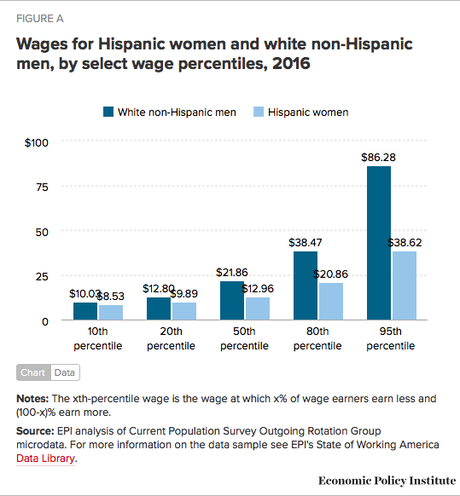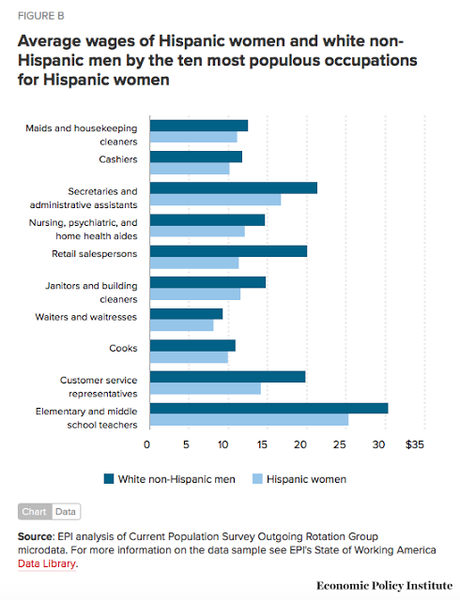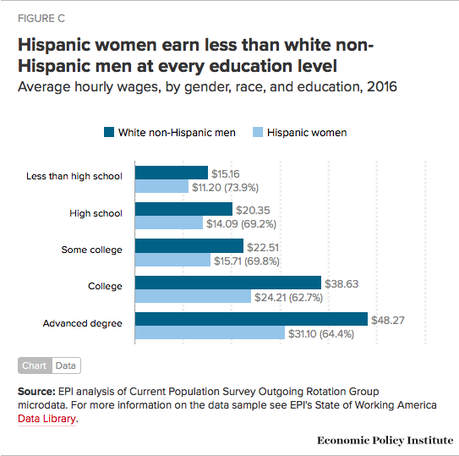


The charts above and the post below are from the Economic Policy Institute. The article was written by Elise Gould and Adriana Kugler:
November 2nd is Latina Equal Pay Day, the day that marks how long into 2017 a Latina would have to work in order to be paid the same wages as her white male counterpart was paid last year. That’s just over 10 months longer, meaning that Latina workers had to work all of 2016 and then this far—to November 2nd!—into 2017 to get paid the same as white non-Hispanic men did in 2016. Unfortunately, Hispanic women are subject to a double pay gap—an ethnic pay gap and a gender pay gap. On average, Latina workers are paid only 67 cents on the dollar relative to white non-Hispanic men, even after controlling for education, years of experience, and location. The wage gap between Latina workers and white non-Hispanic male workers persists across the wage distribution, within occupations, and among those with the same amount of education. Figure A above shows wages for Hispanic women and white non-Hispanic men at select points in their respective wage distributions. The 10th percentile Latina wage identifies the wage at which 10 percent of Latina workers earn less while 90 percent of Latina workers earn more. At the 10th percentile, Latina workers are paid $8.53 per hour, or 85 percent of the white male wage at the 10th percentile ($10.03 per hour). This wage gap—15 percent—is the smallest the gap gets, likely due to the wage floor set by the minimum wage. The gap rises to 41 percent at the middle of the wage distribution, and to 55 percent at the 95thpercentile. That means that even the best paid Latinas are paid half as much as the best paid white non-Hispanic men. Latinas are, thus, vastly over-represented in low-wage jobs and relatively under-represented in high-wage jobs. In fact, Latinas’ median wages are just above those of white men’s 10th percentile wage. In other words, nearly halfof all Latina workers are paid less than the 10th percentile white male worker. Meanwhile, by comparing the white male median to the 80th percentile Latinas’ wages, you can see that more than half of white men are paid over $20 an hour while fewer than 20 percent of Latinas are. At the high end, only 1-in-20 Latina workers are paid more than white male workers at the 80thpercentile. Much of these differences are grounded in the presence of occupational segregation. Latina workers are far more likely to be found in certain low-wage professions than white men are (and less common in high-wage professions). But, even in professions with more Latina workers, they still are paid less on average than their white male colleagues. Figure B shows the average wages of Hispanic women and white non-Hispanic men in the ten most common occupations for Latinas. In every one of them, white men, on average, are paid more than their Latina counterparts. Since Hispanic women continue to be over-represented in low-wage jobs, policies that lift wages at the bottom will have a significant impact on their wages. An increase of the federal minimum wage to $15 by 2024 would affect more than 1-in-5 Latina workers. While some (incorrectly) argue that Latinas are choosing lower-paid professions, further education clearly does not close their sizable wage gaps with white non-Hispanic men. Figure C shows average wages for white men and Latinas in 2016. As Hispanic women increase their educational attainment, their pay gap with white men actually increases. The largest dollar gap (more than $17 an hour), occurs for workers with more than a college degree. Even Hispanic women with an advanced degree earn less than white men who only have a bachelor’s degree. That statistic bears repeating. White non-Hispanic men with only a college degree are paid, on average, $7.53 more than Latinas with an advanced degree! Regardless of their place in the wage distribution, their level of educational attainment, or their occupation, Latinas are paid less than their white male counterparts. The ongoing gender and ethnic discrimination faced by Hispanic women means that ten months into 2017, Latinas finally reach the same typical pay as non-Hispanic white men earned last year. That means that over a 30 year span, Latinas would have to work another 25 years for them to earn the same over their working life as non-Hispanic white men. There is a lot of work to be done to improve the standard of living for the families of Latinas. More educational attainment and access to better quality education would certainly help to improve the Latinas’ chances to move up the job ladder and get better paid jobs. However, this is not the whole story, since even after controlling for education the wage gap remains very large. Offering and facilitating access to occupations that are higher paid will also move Latinas up the occupational ladder. Here too, however, we find that even within the same occupations, Latinas fare worse. Lastly, it is important to improve equal pay for equal work provisions so that those women who do have the same education, the same occupation and are equally qualified in the workplace are not paid less or driven away from moving up to these more challenging positions.

